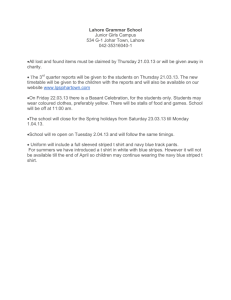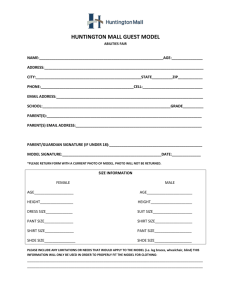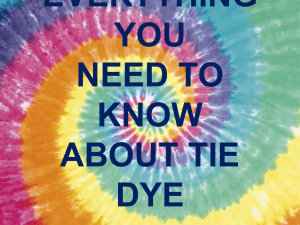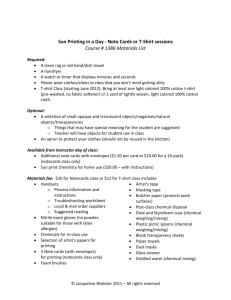Life of a Tshirt.pub
advertisement
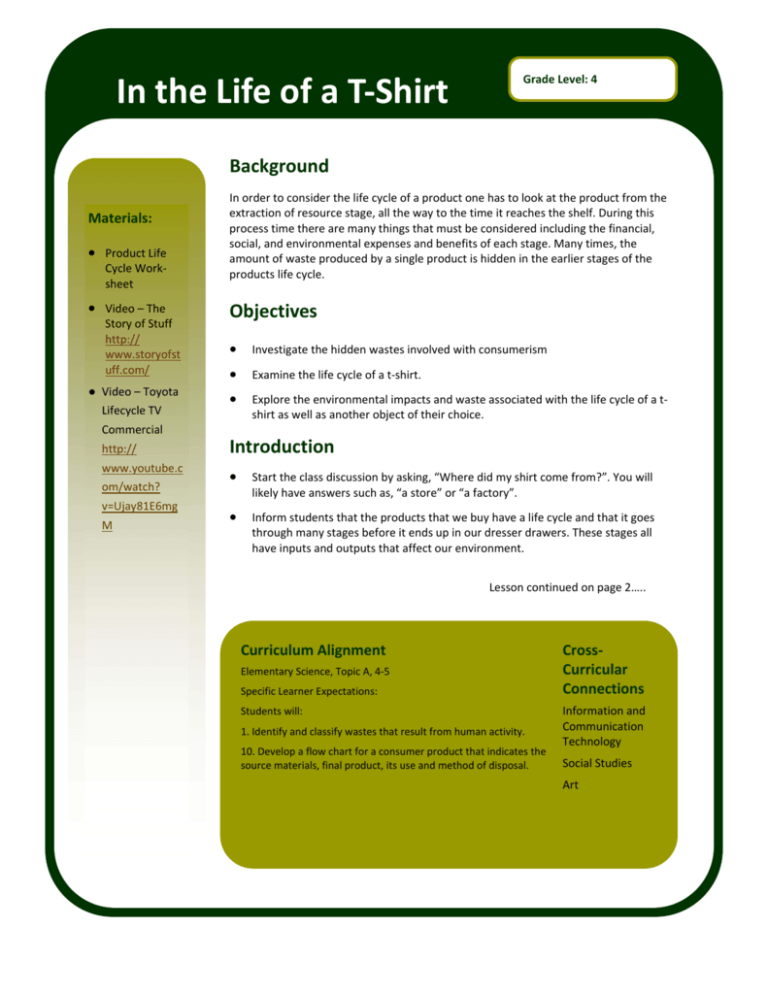
Grade Level: 4 In the Life of a T‐Shirt Background Materials: Product Life Cycle Work‐ sheet Video – The Story of Stuff http:// www.storyofst uff.com/ ● Video – Toyota Lifecycle TV In order to consider the life cycle of a product one has to look at the product from the extraction of resource stage, all the way to the time it reaches the shelf. During this process time there are many things that must be considered including the financial, social, and environmental expenses and benefits of each stage. Many times, the amount of waste produced by a single product is hidden in the earlier stages of the products life cycle. Objectives Investigate the hidden wastes involved with consumerism Examine the life cycle of a t‐shirt. Explore the environmental impacts and waste associated with the life cycle of a t‐ shirt as well as another object of their choice. Commercial http:// Introduction www.youtube.c Start the class discussion by asking, “Where did my shirt come from?”. You will om/watch? v=Ujay81E6mg M likely have answers such as, “a store” or “a factory”. Inform students that the products that we buy have a life cycle and that it goes through many stages before it ends up in our dresser drawers. These stages all have inputs and outputs that affect our environment. Lesson continued on page 2….. Curriculum Alignment Elementary Science, Topic A, 4‐5 Specific Learner Expectations: Students will: 1. Identify and classify wastes that result from human activity. 10. Develop a flow chart for a consumer product that indicates the source materials, final product, its use and method of disposal. Cross‐ Curricular Connections Information and Communication Technology Social Studies Art In the Life of a T‐Shirt Page 2 Activity #1 Watch video: The Story of Stuff (20 minutes) Activity #2 Guide students through the life cycle of a T‐shirt. Create a flow chart similar to the following with classroom input: Instead, try out the Smart Notebook activity: “T‐shirt Life Cycle”! Access online www.lethbridge .ca with this lesson. Source: United Nations Sustainable Consumption Textile Fact Sheet at http://www.tigweb.org/action/ projects/download.html/7849/ As you are working through the flow chart you may wish to discuss the stages in more depth: Raw Materials: Many t‐shirts are made of cotton or synthetic fibers. There is little or no cotton grown in Canada therefore it must be grown in and obtained from another country. Often, the least expensive fibers are available from countries that do not have strict laws about environmental farming practices or child labor to harvest the crops. Processing: Materials such as cotton must be washed, bleached, spun into thread, and then woven into fabric before they can be used. Synthetic materials must be melted down to create the long thin fibers to weave into fabric. Colorful dyes made of harsh chemicals are often used to change the appearance of the fibers. Lesson continued on page 3…... Manufacturing: Fabrics must be cut to size, sewn and often they are printed on with the use harsh chemicals, paints, and dyes. This step is also usually less expensive when done in another country where workers will accept lower pay and undesirable working conditions for adults as well as children. If you check the labels on your own t‐shirts you will likely find that most of the class is wearing a t‐shirt that was made in a country other than Canada. Much energy is used in transportation of these materi‐ als to another country and then back to stores in Canada. Packaging: Many t‐shirts are individually wrapped in plastic, cardboard, and/or paper. They are adorned with tags and packed in boxes. Lesson continued on page 3….. In the Life of a T‐Shirt Page 3 Activity #2 continued… Transport: T‐shirts are transported all over Canada and many other countries for retail sale using a great amount of fossil fuel to get it to all the various places. Use: The t‐shirt is placed for sale in a retail store. Usually the packaging is all discarded and the shirt is hung on a hanger for shopper convenience or the packaging is discarded when the shopper returns home. The t‐shirt must be washed and dried by the consumer many times over in its use using deter‐ gents, bleach, fabric softeners and energy. After product is used it may be recycled, starting the process all over again. It could also be reused or recovered in which the “Use” stage would be prolonged in time. Or finally, the t‐shirt could be discarded to the landfill which would end the cycle. Go over the inputs and outputs of the lifecycle of a t‐shirt as a class and have students fill in the first table on their worksheet Life Cycle Stage Environmental Impact Raw Material Fertilizer, pesticides, energy, wa‐ Processing Energy, cleaners, dyes, water Manufacturing Energy, manufacturing waste Packaging Paper, plastics, cardboard Transport Energy, pollution, fossil fuel Use Detergent, bleach, energy, water, Recycle Reuse/ Recover Disposal Starts at processing stage again Stalls the life cycle waste Activity #3 Arrange students into small groups Have students fill in the blanks of the second table on their worksheet, as a group, to complete the life cycle analysis on the object of their choice Conclusion Lesson continued on page 4… Ask students if anyone feels differently about the products that they buy/ use and how they use that product. There are many manufacturers that are trying to reduce the amount of environmental impact associated with the life cycle of their product – eg. Video ‐ Toyota Lifecycle TV Commercial Lesson continued on page 4….. Page 4 In the Life of a T‐Shirt Extension Activities Have students come up with ideas to reduce the environmental impact over the life cycle duration of a specific product With student input, find an innovative way to reuse or recover a product that would otherwise go to the landfill or the recycling circuit. Local Field Trips/ In‐Class Presentations BFI Recycling Depot ‐ Colin Harms # 403‐328‐6355 Ability Resource Centre ‐ Jane VanLent # 403‐329‐3937 Lethbridge Municipal Landfill ‐ Mary Hughes # 403‐315‐1497 Helen Schuler Nature Centre (Nature Recycles) # 403‐320‐3064 Additional Resources Borrow the NAPCOR preforms from the City of Lethbridge containing materials at various stages of recycled P.E.T to display in the classroom ‐ Borrow the EnviroScape Landfill model from the City of Lethbridge for classroom demonstration and display. Visit the City of Lethbridge website to find out about the municipal landfill at www.lethbridge.ca Helen Schuler Nature Centre 910—4th Ave. S. Lethbridge, AB T1J 0P6 Phone: 403-320-3064 E-mail: hscc@lethbridge.ca Municipalities often have seasonal programs throughout the year! Check out what’s happening at the City of Lethbridge at www.lethbridge.ca Page 5 In the Life of a T‐Shirt Table 1. Life Cycle Analysis of a T‐shirt Name:__________________________________ Life Cycle Stage Environmental Impacts

